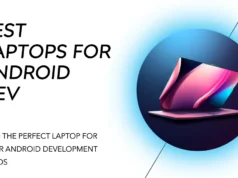Are you a coding enthusiast, a seasoned developer, or a tech-savvy professional searching for the ideal tablet to support your programming endeavors? Look no further!
In this comprehensive guide, we’ll walk you through everything you need to know about finding the best tablet for programming.
Whether you’re working on the go, exploring new coding languages, or seeking a portable development environment, we’ve got you covered.
Programming has become an essential skill in today’s digital world, and having a reliable and efficient device can greatly enhance your coding experience.
With numerous tablets flooding the market, it can be overwhelming to pinpoint the perfect one that caters to your programming needs.
That’s why we’ve compiled this article to simplify your search, save you valuable time, and ensure you make an informed decision.
In this article, we’ll delve into the key factors to consider when selecting a tablet for programming. We’ll explore the specifications, performance capabilities, operating systems, and essential features that make a tablet excel in programming.
Whether you prefer iOS, Android, or Windows, we’ll highlight the best options available for each platform.
Moreover, we’ll showcase a handpicked selection of the finest tablets specifically designed to meet the demanding requirements of programmers.
From powerful processing capabilities and ample storage to high-resolution displays and long battery life, these tablets combine the perfect blend of performance and convenience for coding enthusiasts like yourself.
So, if you’re ready to embark on a journey to find the best tablet for programming, let’s dive into the details and uncover the perfect device that will take your coding skills to new heights.
Let’s get started!
Best Tablet For Programming – Our Top Picks
1. Lenovo ThinkPad X1 Yoga Gen 7
Are you on the hunt for the best tablet for programming? Look no further than the Lenovo ThinkPad X1 Yoga Gen 7.
This top-of-the-line tablet has an Intel Core i7-1270P processor, providing lightning-fast speeds that help you power through even the most demanding programming tasks.
Its 14″ WUXGA IPS touchscreen display boasts a stunning resolution of 1920×1200 and 400 nits brightness, making it easy to see and work on for extended periods.
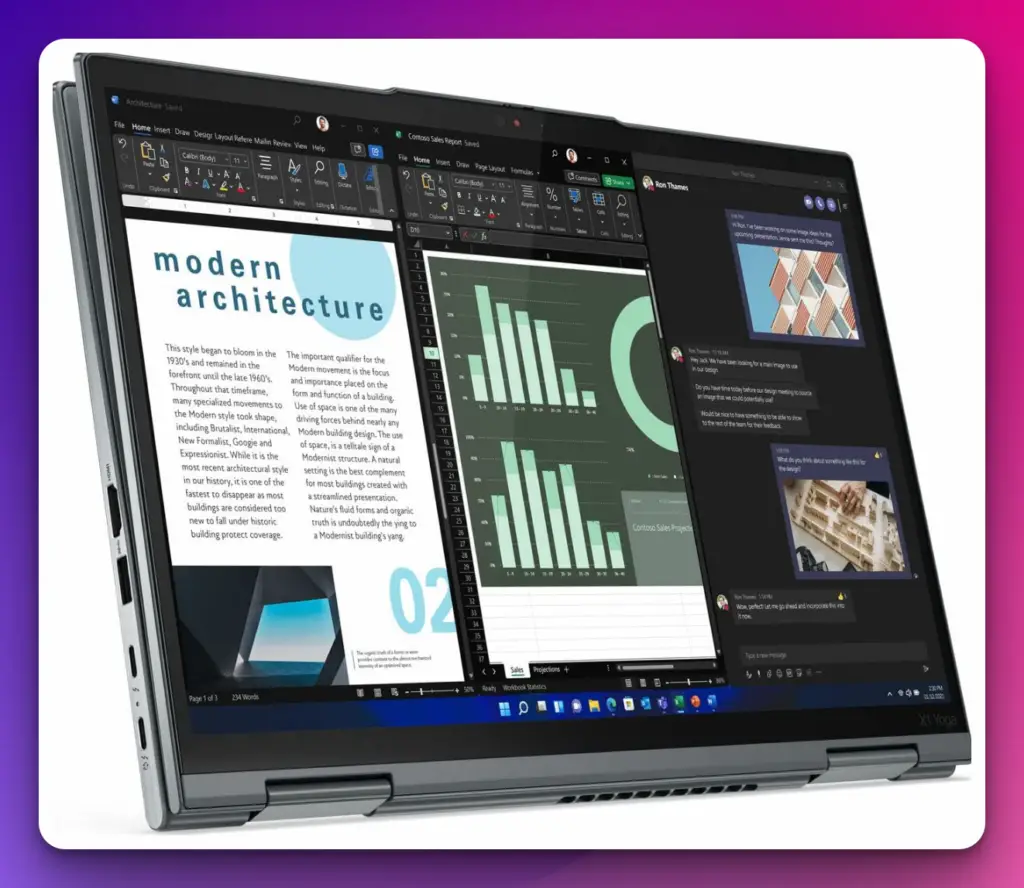
The ThinkPad X1 Yoga Gen 7 also features 16GB of RAM and a 512GB SSD, giving you plenty of space to store your programming files and programs.
And with its backlit keyboard and fingerprint reader, this tablet ensures you can work comfortably and securely.
But perhaps the best thing about the ThinkPad X1 Yoga Gen 7 is its operating system – Windows Pro. This powerful and versatile operating system is the perfect choice for programming, offering a wide range of tools and features that will help you streamline your workflow and optimize your productivity.
So why settle for a subpar tablet when you can have the best? Choose the Lenovo ThinkPad X1 Yoga Gen 7 for your programming needs, and experience unparalleled performance and efficiency.
key specifications:-
here’s a table of the key specifications for the Lenovo ThinkPad X1 Yoga Gen 7:-
| Specification | Details |
|---|---|
| Processor | Intel Core i7-1270P |
| Display | 14″ WUXGA (1920×1200) IPS Touchscreen, 400 nits |
| RAM | 16 GB |
| Storage | 512GB SSD |
| Keyboard | Backlit with Fingerprint Reader |
| Operating System | Windows Pro |
Pros:-
Powerful Processor:- The Intel Core i7-1270P processor ensures excellent performance and smooth multitasking, making it ideal for programming tasks requiring intensive processing power.
High-resolution Touchscreen Display:- The 14″ WUXGA IPS touchscreen with a resolution of 1920×1200 provides crisp and clear visuals, allowing you to work comfortably and effectively, especially when dealing with complex code and intricate details.
Ample RAM:- With 16GB of RAM, the ThinkPad X1 Yoga Gen 7 can handle resource-intensive programming environments, enabling you to run multiple applications simultaneously without experiencing lag or slowdowns.
Fast Storage:- The 512GB SSD offers fast data access speeds for quick program installations and loading times. This enables programmers to efficiently manage and access large projects and datasets.
Backlit Keyboard:- The backlit keyboard ensures you can work in low-light environments, making it easier to code during late-night coding sessions or in dimly lit spaces.
Fingerprint Reader:- The built-in fingerprint reader provides an extra layer of security, protecting your programming projects and sensitive data from unauthorized access.
Windows Pro Operating System:- The Windows Pro operating system offers a wide range of development tools, programming languages, and software compatibility, making it a versatile choice for programmers.
Cons:-
Display Size:- While the 14″ display is adequate for most programming tasks, some programmers may prefer larger screens for better visibility and more screen real estate, especially when working on complex projects.
Resolution Limitation:- The WUXGA resolution of 1920×1200 may not be sufficient for those who require ultra-high-definition displays, particularly when dealing with intricate graphical interfaces or visual programming.
Limited Storage Capacity:- Although the 512GB SSD provides fast storage, it may not be sufficient for programmers working with large datasets, multimedia content, or extensive software libraries. External storage options can help mitigate this limitation.
Price:- As a high-end device with powerful specifications, the ThinkPad X1 Yoga Gen 7 may have a higher price tag than other tablets, which could be a limiting factor for budget-conscious programmers.
Touchscreen Limitations:- While the touchscreen feature can be beneficial for certain programming tasks, it may not be extensively utilized in all programming workflows, potentially making it more of an optional rather than an essential feature.
Windows OS Dependency:- The ThinkPad X1 Yoga Gen 7 comes with the Windows Pro operating system preinstalled, which may not be the preferred choice for programmers who favor alternative operating systems like macOS or Linux.
2. Google Pixel Slate
Looking for the best tablet for programming? Look no further than the Google Pixel Slate 12.3-Inch 2 in 1 Tablet.
With its powerful Intel Core m3 processor, ample 8GB RAM, and spacious 64GB storage capacity, this tablet is designed to meet the demands of programmers and developers.
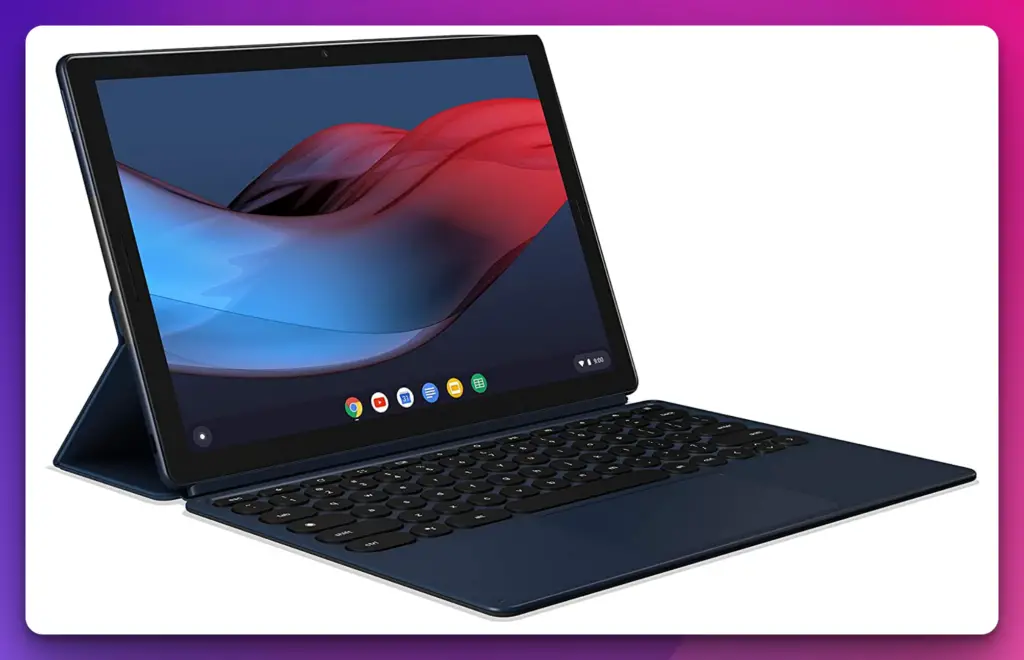
One key feature that sets the Google Pixel Slate apart is its 3:2 aspect ratio. This aspect ratio provides more vertical screen space, allowing you to view more lines of code and work more efficiently.
Whether coding, debugging, or designing interfaces, the Pixel Slate’s display ensures you have the optimal viewing experience.
The Intel Core m3 processor inside the Pixel Slate delivers impressive performance and power efficiency, making it ideal for programming tasks.
It can easily handle resource-intensive programming software and tools, enabling you to compile code, run simulations, and test applications seamlessly.
With 8GB of RAM, the Pixel Slate ensures smooth multitasking and allows you to work on multiple projects without lag or slowdown.
This tablet’s ample RAM capacity ensures you can run resource-heavy programming environments, such as IDEs and virtual machines, without compromising performance.
In addition, the Pixel Slate’s 64GB storage capacity provides ample space to store your code repositories, project files, and development tools.
Should you need more storage, you can use Google Drive’s cloud storage options to ensure your work is securely backed up and accessible from anywhere.
The Pixel Slate’s versatility is another reason it is the best tablet for programming. Its 2-in-1 design allows you to use it as a tablet and a laptop with a detachable keyboard.
This flexibility means you can adapt to different programming scenarios, whether working on the go or needing a more traditional laptop-like setup.
As a Google product, the Pixel Slate runs on Chrome OS, which provides a streamlined and secure operating system for programmers.
You’ll have access to various programming tools and software through the Chrome Web Store, including popular text editors, integrated development environments (IDEs), and language-specific frameworks.
Last but not least, the Pixel Slate features a long-lasting battery life, so you can work for extended periods without worrying about running out of power.
This ensures you stay productive throughout your coding sessions, whether on a long flight or at a coffee shop.
In conclusion, the Google Pixel Slate 12.3-Inch 2 in 1 Tablet with its Intel Core m3 processor, 8GB RAM, 64GB storage, and 3:2 aspect ratio is the best tablet for programming.
Its powerful performance, ample storage, versatile design, and Chrome OS make it an excellent choice for programmers and developers who need a reliable and efficient device to bring their ideas to life.
Key Specifications:-
here’s a table highlighting the key specifications of the Google Pixel Slate 12.3-Inch 2 in 1 Tablet:-
| Specification | Description |
|---|---|
| Display Size | 12.3 inches |
| Resolution | 3000 x 2000 pixels |
| Aspect Ratio | 3:2 |
| Processor | Intel Core m3 |
| RAM | 8GB |
| Storage | 64GB |
| Operating System | Chrome OS |
| Battery Life | Up to 12 hours |
| Weight | 1.6 pounds (tablet only) |
| Dimensions | 11.45 x 7.95 x 0.28 inches |
| Ports | 2 x USB-C |
| Wireless Connectivity | Wi-Fi, Bluetooth 4.2 |
| Cameras | 8MP rear-facing camera, 8MP front-facing camera |
| Sensors | Ambient Light Sensor, Accelerometer, Gyroscope, Magnetometer |
| Audio | Dual front-facing speakers, 2 microphones |
| Keyboard | Detachable keyboard (sold separately) |
| Pen Support | Pixelbook Pen (sold separately) |
Pros:-
Portability: The tablet form factor of the Pixel Slate makes it highly portable, allowing programmers to work on their projects from anywhere, whether it’s a coffee shop, co-working space, or while traveling.
Versatility: The 2-in-1 design of the Pixel Slate gives programmers the flexibility to use it as both a tablet and a laptop, adapting to different programming scenarios and preferences.
Ample RAM: With 8GB of RAM, the Pixel Slate can handle resource-intensive programming tasks, allowing for smooth multitasking and running of multiple development environments and tools simultaneously.
Efficient Display: The 3:2 aspect ratio and spacious 12.3-inch display provide ample vertical screen space, enabling programmers to view more lines of code and work more efficiently, reducing the need for constant scrolling.
Powerful Processor: The Intel Core m3 processor ensures fast and responsive performance, capable of handling complex coding, compiling, and running of applications without significant lag or slowdown.
Chrome OS: The Chrome OS operating system on the Pixel Slate offers a streamlined and secure environment for programming, with access to a wide range of programming tools and software available through the Chrome Web Store.
Cons:-
Limited Storage: While the Pixel Slate provides 64GB of storage, it may not be sufficient for programmers working with large code repositories, datasets, or multimedia assets. However, cloud storage options like Google Drive can help alleviate this limitation.
Software Compatibility: Some specific software or development environments may not be available or optimized for Chrome OS, limiting the options for certain programming tools or requiring workarounds to ensure compatibility.
Keyboard and Pen Sold Separately: The detachable keyboard and Pixelbook Pen are not included in the Pixel Slate and must be purchased separately. This adds additional cost if you prefer a physical keyboard or require stylus input for your programming tasks.
Limited App Ecosystem: While the Chrome Web Store offers a decent selection of programming tools and web-based applications, it may not have the same breadth and depth of software options on other platforms like Windows or macOS.
Limited Processing Power: Although the Intel Core m3 processor provides solid performance, it may not be as powerful as some higher-end processors in traditional laptops. This could impact the performance of resource-intensive programming tasks or demanding software.
3. SAMSUNG Galaxy Tab S8
If you’re looking for the best tablet for programming, look no further than the SAMSUNG Galaxy Tab S8.
With its powerful 256GB storage capacity, WiFi 6E connectivity, and advanced Android operating system, this tablet is the perfect tool for developers and coders on the go.
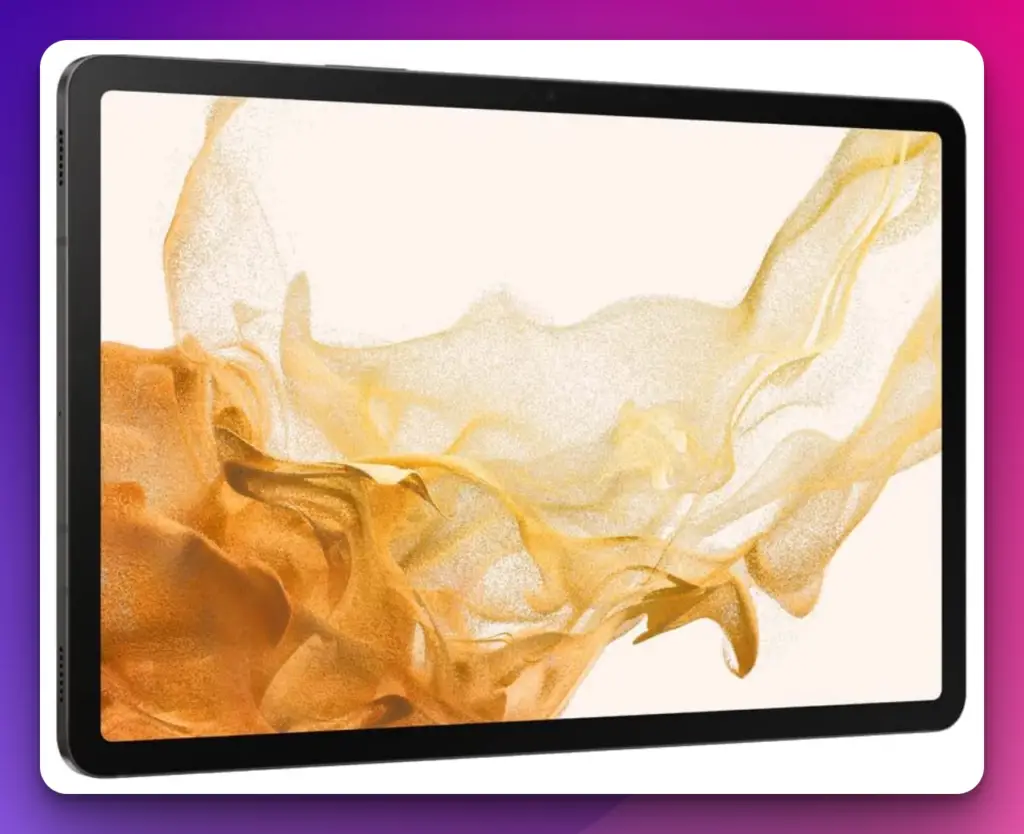
One of the standout features of the SAMSUNG Galaxy Tab S8 is its large LCD screen, which provides a spacious canvas for coding and programming.
This means you can see your code in great detail and easily work on your projects, even when you’re away from your computer.
But the benefits of the SAMSUNG Galaxy Tab S8 don’t stop there. With its included S Pen, you can easily take notes, annotate code, and sketch out ideas, making it an essential tool for any programmer who needs to work on the go.
The tablet also features a long-lasting battery, so you won’t have to worry about running out of juice during a coding session.
And with its ultra-wide camera, you can take photos of code snippets or scan barcodes for easy access to relevant information.
So if you’re looking for a tablet that can keep up with your programming needs, look no further than the SAMSUNG Galaxy Tab S8.
Its powerful features and cutting-edge technology make it the best tablet for programming on the market today.
key specifications:-
Here is a table summarizing the key specifications of the SAMSUNG Galaxy Tab S8:-
| Specification | Details |
|---|---|
| Operating System | Android 12 |
| Processor | Qualcomm Snapdragon 888 |
| RAM | 8GB |
| Storage | 256GB (expandable up to 1TB with microSD card) |
| Display | 11-inch WQXGA (2560 x 1600) LCD, 120Hz refresh rate |
| Camera | Rear: 13MP ultra-wide, Front: 8MP |
| Battery | 8000mAh, up to 12 hours of video playback |
| Connectivity | WiFi 6E, Bluetooth 5.2, USB-C 3.2 Gen 1, GPS, GLONASS |
| Dimensions | 7.63 x 10.09 x 0.22 inches (193.8 x 256.2 x 5.7 mm) |
| Weight | 1.26 pounds (571g) |
| Included Stylus | S Pen (included in box) |
| Color | Graphite |
| Price | $849.99 (MSRP) for the 256GB WiFi-only version |
Pros:-
Powerful hardware:- The tablet has a robust processor and ample RAM, providing the necessary horsepower to handle resource-intensive programming tasks and run multiple applications simultaneously.
Large LCD screen:- The spacious and high-resolution display allows for comfortable coding and ample screen real estate to view code, debug, and navigate complex projects.
S Pen integration:- The included S Pen stylus offers precise and intuitive input, making it easier to write and edit code, annotate documents, and sketch out ideas. It enhances the overall productivity and flexibility of the tablet for programming purposes.
Portable and lightweight:- The tablet’s slim and lightweight design makes it highly portable, enabling programmers to work from anywhere, be it a coffee shop, library, or during travel. It provides the flexibility to code on the go without compromising on performance.
Ample storage:- With a generous 256GB storage capacity, the tablet offers plenty of space to store programming files, projects, and related resources, ensuring you have everything you need.
Connectivity options:- The tablet supports WiFi 6E, ensuring fast and reliable internet connectivity for seamless online research, collaboration, and access to cloud-based development tools and services.
Cons:-
Limited software ecosystem:– While the tablet runs on the popular Android operating system, the software ecosystem for programming and development tools is more extensive on traditional desktop and laptop platforms like Windows and macOS. Some specialized programming tools and environments may have limited availability or functionality on Android.
Lack of physical keyboard:- Although the tablet supports external keyboards, the on-screen keyboard may not be as comfortable or efficient as a physical keyboard for long coding sessions. This could be a drawback for programmers accustomed to tactile feedback and faster typing speeds.
Limited multi-tasking:- While the tablet can run multiple applications simultaneously, the multitasking experience may not be as seamless or flexible as on a desktop or laptop computer. Switching between coding environments, IDEs, or tools may be less efficient.
Limited software customization:– Compared to traditional computing platforms, software customization and control over the operating system may be more restricted on a tablet. This can limit the ability to fine-tune development environments or install custom software configurations.
Dependency on touch-based interaction:- Although the S Pen provides precise input, touch-based interaction may not be as efficient or comfortable for certain programming tasks as a mouse or trackpad. Fine-grained control and precision may be challenging in some scenarios.
Overall, while the SAMSUNG Galaxy Tab S8 offers many advantages for programming on the go, it’s important to consider individual programmers’ specific needs and preferences when evaluating its suitability for their programming workflows.
4. Microsoft Surface Go 2
Introducing the new Microsoft Surface Go 2 – the best tablet for programming in its class! Packed with cutting-edge features and unparalleled versatility, this latest model is designed to take your coding skills to new heights.
First and foremost, the 10.5″ touch-screen display offers a brilliant canvas for your coding endeavors. With its high resolution and vibrant colors, you’ll experience exceptional clarity, ensuring that every line of code is crystal clear.
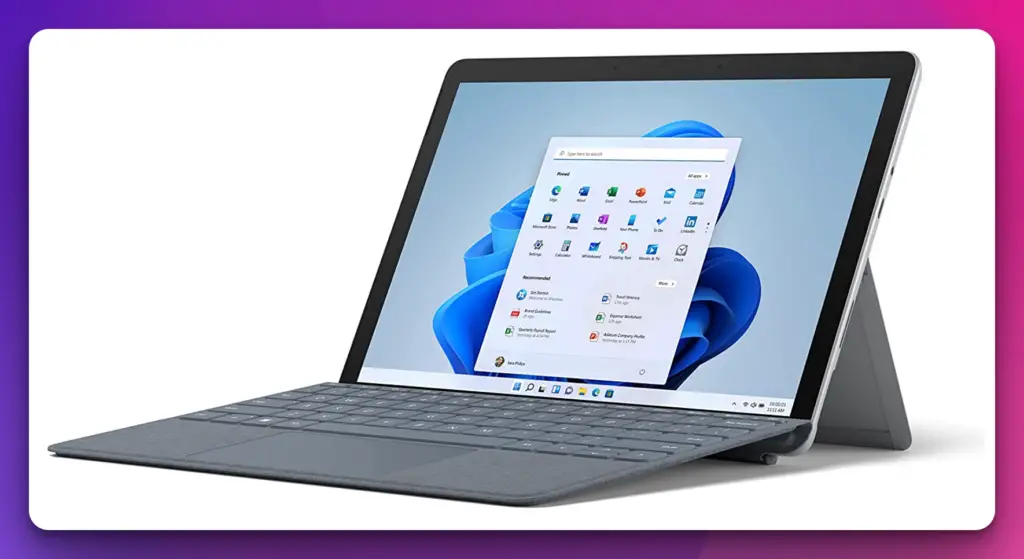
The responsive touch interface allows for effortless navigation and precise interaction with your programming tools, making coding a breeze.
Under the hood, the Intel Pentium processor delivers the performance you need to tackle complex programming tasks effortlessly. This tablet keeps up with your demanding workflow, from compiling code to running resource-intensive applications.
With 4GB of memory, you can easily multitask, seamlessly switching between programming environments, documentation, and browser tabs without any slowdowns.
Storage capacity is another critical factor for programmers, and the Surface Go 2 doesn’t disappoint. With 64GB of storage, you’ll have ample space to store your projects, code libraries, and essential software.
Plus, with the option to expand the storage using the MicroSD card slot, you can ensure you never run out of space.
Connectivity is a vital aspect of any programming device, and the Surface Go 2 offers Wi-Fi capabilities, keeping you connected to the internet and cloud services wherever you go.
You can quickly access online resources, collaborate with teammates, and leverage cloud-based tools to enhance your programming efficiency.
Its remarkable versatility sets the Surface Go 2 apart from the competition. It can effortlessly transition from a tablet to a laptop with the optional detachable keyboard, allowing you to code comfortably in any setting.
The adjustable kickstand provides the perfect viewing angle, whether working at a desk, in a coffee shop, or on the go.
Furthermore, the Surface Go 2 runs on the latest version of Windows, offering seamless integration with popular programming tools and software.
You’ll have access to the extensive library of development environments, code editors, and compilers available on the Windows platform, ensuring compatibility and familiarity with your preferred tools.
To top it all off, the sleek and stylish platinum design of the Surface Go 2 exudes professionalism and sophistication. Whether presenting your work to clients, attending meetings, or working collaboratively, this tablet will make a lasting impression.
In conclusion, if you’re searching for the best tablet for programming, the Microsoft Surface Go 2 is the clear winner.
With its powerful performance, intuitive touch-screen display, ample storage, and remarkable versatility, it’s a tool that will elevate your programming skills to new heights.
Don’t miss out on this latest model – unlock your coding potential today!
Pros:-
Portability:- The compact size and lightweight design of the Surface Go 2 make it highly portable, allowing programmers to work on their projects from anywhere. Whether coding on the go or working in tight spaces, this tablet is easy to carry and convenient.
Touch-screen interface:- The display offers a more intuitive and interactive programming experience. You can navigate through code, zoom in and out, and interact with programming tools using touch gestures, enhancing your workflow and efficiency.
Versatility:- The Surface Go 2 can be transformed from a tablet into a laptop-like device with a detachable keyboard. This versatility enables programmers to switch between touch-based coding and traditional keyboard input, adapting to different coding scenarios and personal preferences.
Windows compatibility:- Running on the latest version of Windows, the Surface Go 2 ensures compatibility with a wide range of programming tools, code editors, and development environments. You can seamlessly install and use your preferred programming software without compatibility issues.
Ample storage options:- With 64GB of built-in storage and the option to expand it using the MicroSD card slot, the Surface Go 2 provides sufficient space to store your projects, code repositories, and related files.
You can keep your work organized and accessible without worrying about running out of storage.
Cons:-
Limited processing power:- While the Intel Pentium processor offers decent performance for general programming tasks, it may struggle with resource-intensive programming tasks, such as compiling large projects or running complex simulations. High-end programming or development work may require more powerful hardware.
Limited memory:- The Surface Go 2 has 4GB of memory, which may be insufficient for heavy multitasking or running memory-intensive applications.
Limited memory could lead to slower performance when working with multiple programming environments or having numerous browser tabs open simultaneously.
Small screen size:- Although the 10.5″ touch-screen display is vibrant and responsive, some programmers may find the screen size restrictive for viewing and editing code. Working on complex projects or reading lengthy lines of code may require zooming in and scrolling more frequently, affecting productivity.
Keyboard limitations:- The detachable keyboard, while offering convenience, may not provide the same typing experience as a dedicated laptop keyboard. Smaller and potentially shallower key travel may not be as comfortable for programmers who spend extended time typing.
Limited connectivity options:- The Surface Go 2 primarily relies on Wi-Fi for internet connectivity, which may pose limitations in environments without Wi-Fi access or in areas with unstable connections.
A lack of Ethernet or limited USB ports can also impact connecting to additional peripherals or external devices.
While the Microsoft Surface Go 2 offers several advantages for programming, it’s essential to consider these potential limitations to determine if it aligns with your specific programming needs and requirements.
5. 2021 Apple 11-inch iPad Pro
The 2021 Apple 11-inch iPad Pro has a monitor 11″ in size, offering you eloquent image quality. That is possible because of the liquid retina in it. There is also the True Tone and P3 wide color.
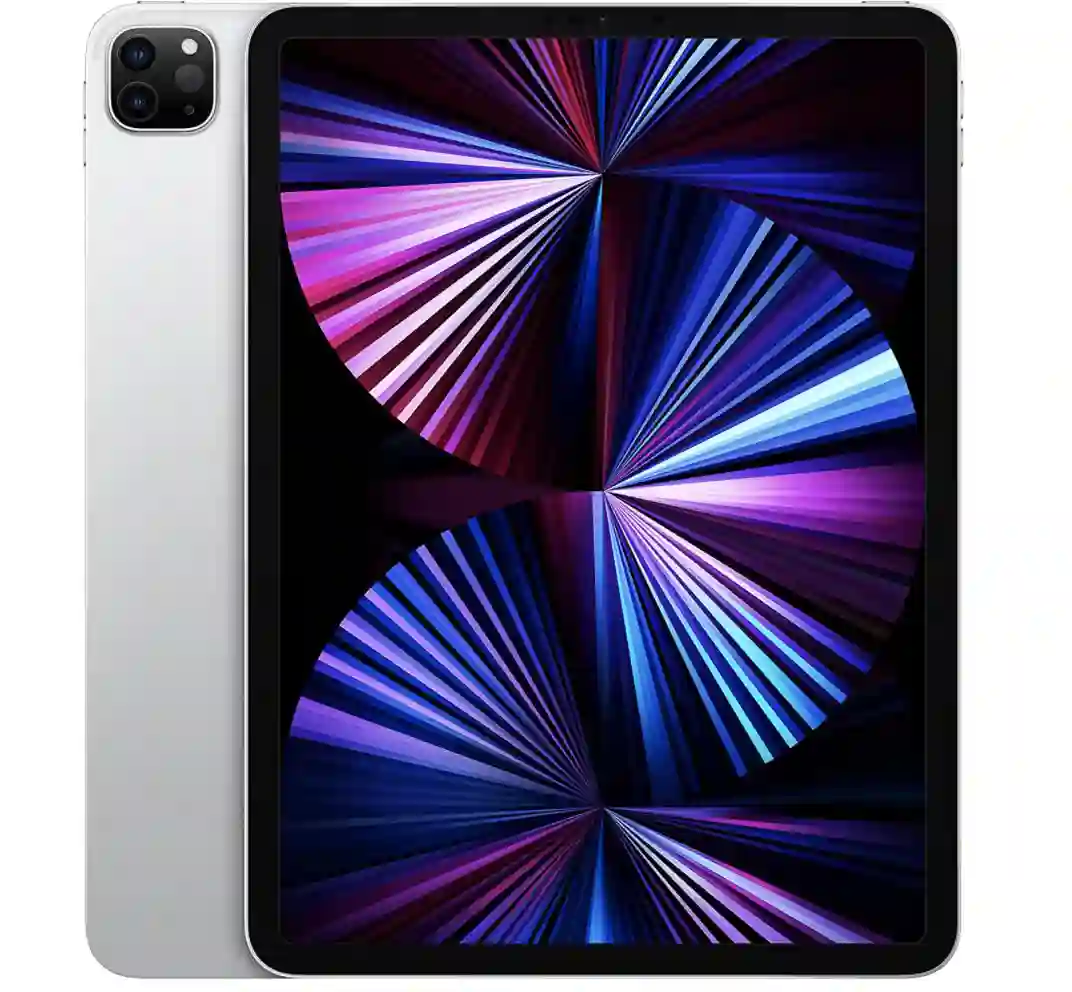
It is pretty simple to use. You can perform anything you want using the multi-touch monitor. The powerful device enables you to operate apps that include programming languages, MS Office, Photoshop, and top-end games.
The device is portable and comes with Wi-Fi connectivity. You can use it as a notepad, film studio, scanner, or canvas as & when you want to.
The model has the Apple M1 chip infused, giving you next-level performance, and the TrueDepth camera system comes with a decent front camera.
The camera can work splendidly because of the 10MP ultra-wide camera and 12MP wide camera. Its connectivity is not a problem as it comes with a barrage of them, including displays, external storage, and docks.
This way, you can connect to your device during meetings, conferences, seminars, etc. There is also a particular security feature in place, the Face ID. You know that nobody else can log in to your system besides you.
Using the device, you can use the secure mode of payment from Apple, Apple Pay. There are also 4-speaker audio and 5 microphones that offer you top-notch sound quality. It provides adequate support in the Apple Pencil (2nd generation).
You can also work using the Smart Keyboard Folio & magic keyboard. A user has written that this is the best iPad he has used in a long time.
The M1 chip works like a charm. He is quite satisfied with the front camera on it, and the 120Hz refresh rate is acceptable.
However, the user feels it is not worth upgrading if you own the iPad Pro 2021 model. The unit does not have the liquid retina XDR screen on the 12.9″ tablet. But when you are keen on using the M1 chip and noting the performance, then why not?
It is priced at less than $1482. When you want to work on a larger screen, then it is not a problem. You can always use the 12.9″ iPad Pro that is also available.
It sells for a higher price than the one we read about. But the features & specifications are almost the same.
Pros:-
- It is lightweight and portable.
- It is feature-intense.
- The models are quite flexible.
- The storage space is up to 2GB.
- The tablet offers 10 hours of battery working.
Cons:-
- The unit is quite expensive.
The 2021 Apple 11-inch iPad Pro is the best programming tablet with many sublime features. You can use it for programming, coding, gaming, and other activities.
The portable unit offers you remarkable storage space and decent battery life.
6. SAMSUNG Galaxy Tab S7 11-inch Android Tablet
SAMSUNG Galaxy Tab S7 11-inch Android Tablet is the best android tablet for developers. Just like one programmer said, he accidentally pushed his laptop off the bed.
He realized he needed a smaller device to enhance his programming tasks.
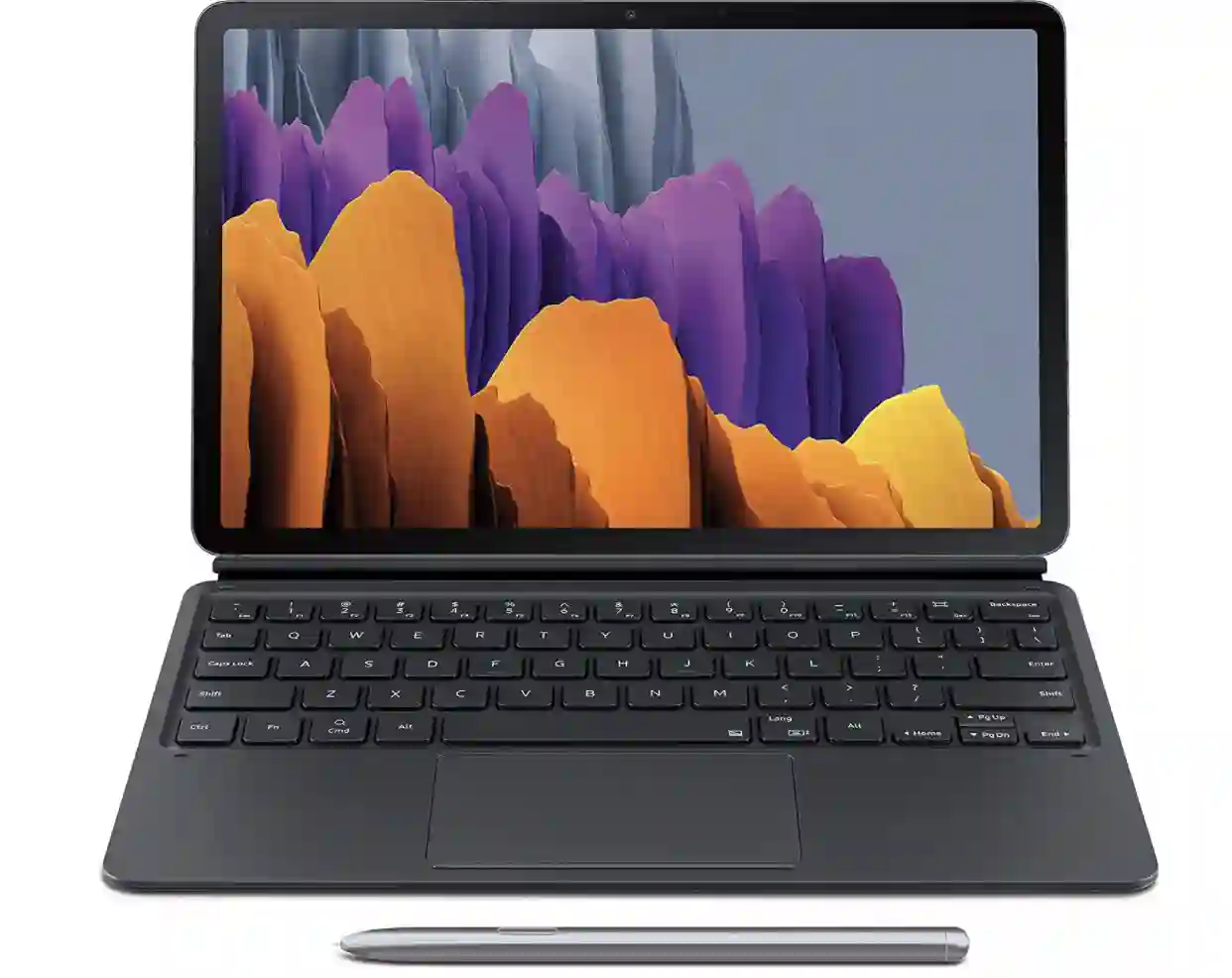
If you want to work on the PC, you can use DeX mode. The tablet has an expanded trackpad and an optional keyboard. The keyboard has to be bought separately and is produced from plastic.
Thanks to the large 11″ monitor, it provides you with edge-to-edge displays. It also comes with an LCD monitor along with the Dolby Atmos feature. The stylus pen is one of the main reasons we decided to have this gem of a device on our list.
It has enhanced 9ms pen latency and can help you control your presentations effortlessly. The unit is also ideal for gamers because of the Wi-Fi connectivity and the Bluetooth-enabled controller.
It has a decent battery life of 15 hours, and the device also charges pretty quickly. The model can be charged using the USB-C port. You can experience fantastic clarity with the camera infused with a rear 13MP and a front 8MP camera.
The storage space of 128GB lets you save your work files and documents seamlessly. It can be upgraded to 1TB memory if you want. It comes embedded with the Qualcomm Snapdragon processor.
A California user says he purchased the device because of its smooth design. He has the bronze color and is amazed by its elegance of it. Besides, he finds the pen extremely useful in his programming work.
Pros:-
- The unit is relatively lightweight and portable.
- It has a massive 128GB storage space upgradeable to 1TB.
- It comes with an edge-to-edge display screen.
- The tablet has a functional stylus pen for enhancing your programming and design work.
- The product has a colossal battery life of 15 hours.
Cons:-
- The plastic keyboard is not something all users will prefer.
This model could be the best alternative for the iPad Pro or Air if you would like. However, they need to work on improvements on the keyboard & the stylus pen.
7. Google Pixelbook
The Google Pixelbook is next on our list. The tablet is more of a Chromebook with good performance. You will be delighted to know that it is the first device with Google Assistant infused in it.
You need to press the Google Assistant key and say “ok Google” to begin. The laptop has eloquent features like the Intel Core 7th gen i5 processor, 8GB RAM, and close to 128GB storage space.
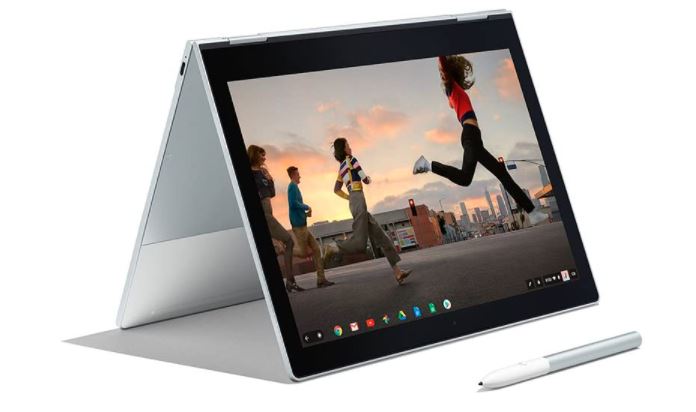
The battery works for more than 11 hours and can get charged in under 2 hours. This model is highly recommended for programmers as they can use it as a tablet, laptop, tent, and even other modes if they want to.
Coders can do plenty of things using the model besides programming. You can browse your emails, do light painting, and use a host of Google apps. It measures only 2.4 pounds and has a flexible monitor for 360 degrees.
Besides, you can also work peacefully at night using the backlit keyboard. The bootup of the model is very quick, coming in at 6 seconds.
The maker has given it an automatic software update. A user who is located in the USA said this about the tablet.
Though he prefers iOS, he was stunned by the device’s performance. The consumer is a programmer who mainly uses the unit for reading, browsing, and watching videos.
However, he is extremely satisfied with the tablet’s functionality and feels it is much better than the MacBook.
It is priced at less than $651. This price point makes it quite affordable, ensuring you can do a barrage of activities like programming, designing, & gaming. The unit is most suitable for programmers & gamers.
Pros:-
- The product is lightweight and easy to use.
- It has sufficient Google apps to work with.
- It comes with a powerful processor.
- The unit is quite affordable.
- The tablet has a decent battery working life.
Cons:-
- Being a Google product, it is more inclined toward Google apps.
Not to mention, the processor, battery life, and functionality are pretty good.
8. Microsoft Surface Pro (5th Gen)
Microsoft Surface Pro (5th Gen) is a fantastic product from the makers of Microsoft. You know instantly that this is a product to reckon with.
Don’t be surprised if you find the best tablet for computer science students in the hands of most programmers around the globe.
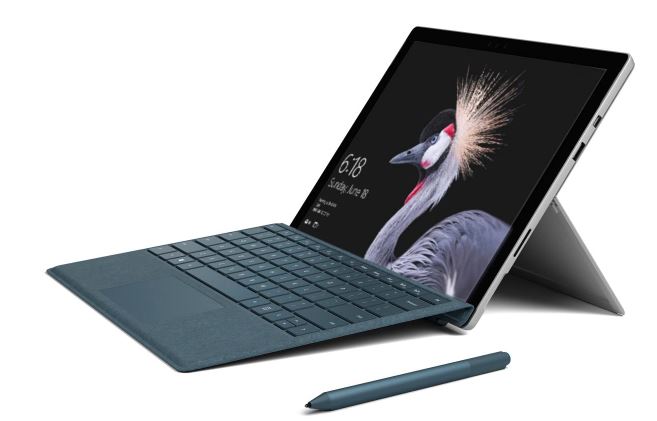
The device’s connectivity is outstanding as it has powerful Wi-Fi infused. Surface Pro has a decent flexible capability providing you to work, study, and play games.
It is beneficial not only for programmers but also for a wide range of other users.
You can work on most of the Windows operating systems released in the market, like Windows 8.1, 7, XP, and 10. The keyboard’s design is one of the best in the market, offering excellent writing capabilities.
Your typing becomes smooth. Most of the units sold in the market do not have keyboards. The processor on the device is the Intel Core i5 offering you sufficient power for working on several tasks efficiently.
The storage space on the device is 8GB RAM and 256GB capacity. Its benefit is that the model offers you the incredible ability to work and provides a Windows experience.
You can utilize the Surface Dial and Office Surface Pen, which can operate on the 3D creation tools.
You can work on it with the tablet, laptop, and studio modes. Besides programmers & coders, designers and video creators can use it with the studio mode. It has a battery life of more than 14 hours.
The model weighs 1.7 pounds. You can place it inside your backpack and move around quickly. You won’t even know that your tablet is inside there. It is priced at less than $700. This is a flexible device that can offer you stunning capabilities.
Pros:-
- It is exceptionally light and easy for travel purposes.
- The model has a powerful Windows working ability.
- It comes with a dazzling processor & storage space.
- The Surface pen provides you with a fantastic writing experience.
- The battery life of close to 14 hours is exceptional.
Cons:-
- The features are not powerful compared to devices in the price range.
Microsoft Surface Pro (5th Gen) is an exceptional device ideal for programmers. You can also do other tasks like browsing, reading, and typing with it.
Though it inclines too much on the Windows tools & apps, Apple fans can consider using it if they plan on getting the unit.
Check Price on Amazon9. ASUS Chromebook Flip
ASUS Chromebook Flip is the best tablet for programming. We can say that because it comes from the makers of Asus and has some incredible specifications infused in the unit. This model has a 14″ touchscreen that has a 4-way NanoEdge display.
It also has a resolution of 1920×1080 that comes with ultra-narrow bezels measuring only 5 mm. The size also suits programmers looking for a small but handy laptop.
You will be surprised that the 360-degree hinge lets you rotate the device effortlessly.
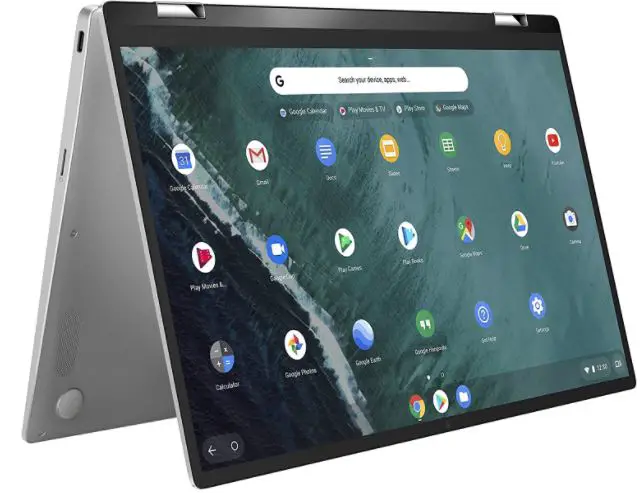
That means you can use it as a tablet, stand, tent, or laptop, depending on your purpose. The model comes embedded with the powerful Intel Core m3-8100Y processor for quick performance.
If you like working with 20-40 tabs open simultaneously, this is your ideal choice. Typing must not be a hindrance because it has a backlit keyboard. Besides, the connectivity options in it are tremendous.
It is designed using a durable aluminum body that provides an elegant appearance. The battery life of the device can run for 10 hours. It weighs only 2.9 pounds, making it suitable for travel.
You could be a programmer or gamer looking for a portable device in your backpack. It is priced at less than $580. This price is reasonable, and it is indeed a feature-rich product with a brand attached.
Pros:-
- The laptop has stunning image quality.
- The model comes with decent specs.
- The unit has powerful battery life.
- It is a brand for value for a product.
- It is pretty light and ideal for travel.
Cons:-
- The keyboard is not light and responsive.
ASUS Chromebook Flip is an outstanding choice for any coder. It comes infused with some stunning specifications. The unit has a powerful processor and decent specifications for efficiency, portability, and affordability.
Check Price on Amazon10. SAMSUNG Galaxy Tab A8
The SAMSUNG Galaxy Tab A8 is a great option for programming on the go. Its 10.5-inch LCD screen offers a crisp, colorful display that simplifies reading and writing code.
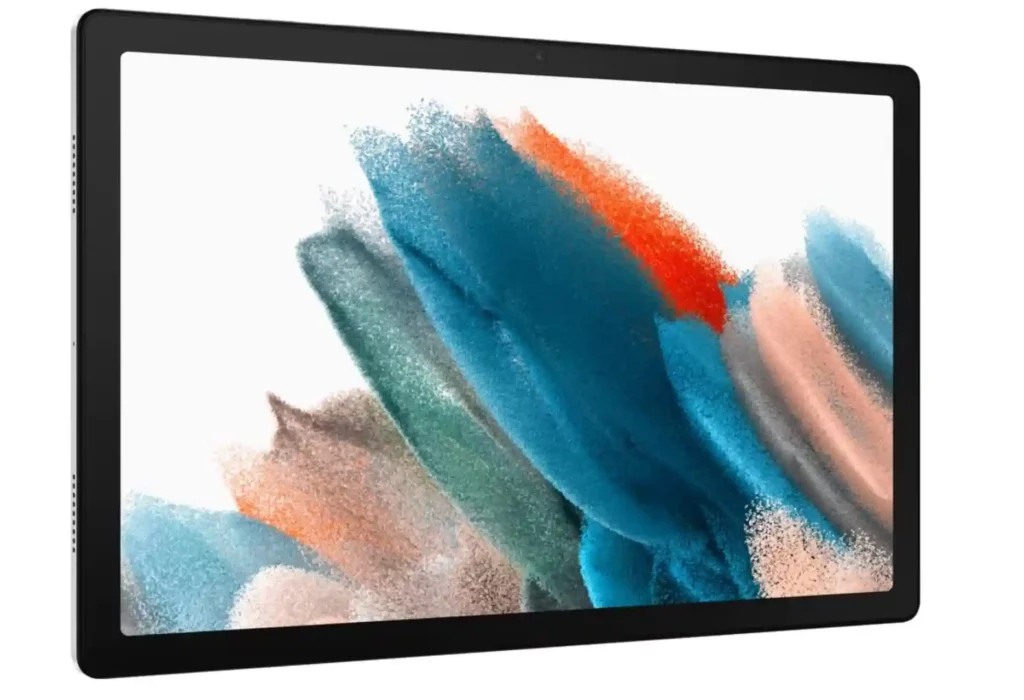
The 32GB of storage on the tablet is more than adequate for all your programming resources, and the expandable memory lets you add extra storage if necessary.
The Galaxy Tab A8’s powerful battery is one of its most notable characteristics. You can work on your programming projects for an extended period without worrying about running out of power, thanks to up to 14 hours of usage time; for people who require a dependable gadget to work on while always on the road, this is extremely practical.
The Galaxy Tab A8 includes a ton of kid-friendly material in addition to its performance skills. Because it offers a secure and instructive environment for kids to learn and play, it is a perfect tablet for families.
Even the most difficult programming tasks can be easily completed thanks to its high-quality display and expandable memory. The family may use it because of the kid-friendly content.
Check Price on AmazonBest tablet for computer Science students
In computer science, a good tablet can make all the difference. A computer science student needs a powerful, efficient, and versatile device. With so many options on the market, it can be difficult to decide which tablet is best suited for your needs.
One of the best tablets for computer science students is the Microsoft Surface Pro 7. This powerful device offers a 10th-generation Intel Core processor, up to 16GB of RAM, and a fast SSD hard drive.
The detachable keyboard and stylus make it perfect for taking notes and sketching out ideas. Additionally, the Surface Pro 7 has a long battery life, so you won’t have to worry about running out of juice during long study sessions.
Another great option is the Apple iPad Pro. With its powerful A12Z Bionic chip and Liquid Retina display, the iPad Pro is perfect for programming, graphic design, and other computationally intensive tasks. The Apple Pencil and Smart Keyboard Folio make it a versatile tool for taking notes and sketching ideas.
The Samsung Galaxy Tab S7 is a great option if you’re on a budget. With a Snapdragon 865+ processor, 6GB of RAM, and a beautiful 11-inch display, this tablet is a powerful tool for computer science students.
The included S Pen is perfect for taking notes and sketching out ideas, and the long battery life means you can study for hours without needing to recharge.
here is a table comparing some of the best tablets for computer science students:-
| Tablet | Operating System | Display Size | Processor | RAM | Price |
|---|---|---|---|---|---|
| iPad Pro | iPadOS | 11″ / 12.9″ | Apple M1 chip | 8GB / 16GB | $799-$1,099 |
| Microsoft Surface | Windows 10 | 12.3″ | Intel Core i5 / i7 | 8GB / 16GB | $799-$2,299 |
| Samsung Galaxy Tab | Android | 10.4″ / 11″ | Qualcomm Snapdragon 865+ | 6GB / 8GB | $349-$729 |
| Google Pixel Slate | Chrome OS | 12.3″ | Intel Core m3 / i5 / i7 | 8GB / 16GB | $799-$1,599 |
| Lenovo ThinkPad X1 | Windows 10 | 13″ | Intel Core i7 | 16GB / 32GB | $1,209-$2,409 |
Best Tablet for web development
Regarding web development, having the perfect tool at your fingertips can greatly enhance productivity and efficiency.
A tablet designed specifically for web development can be a game-changer, allowing you to code, design, and test websites easily. In this article, we will explore the top contenders for the title of the best tablet for web development.
First on our list is the iPad Pro, an absolute powerhouse for web development. With its cutting-edge features and sleek design, the iPad Pro provides an exceptional user experience.
Equipped with a powerful M1 chip, it effortlessly handles demanding tasks, making coding and designing a breeze. The 11″ or 12.9″ display offers ample screen real estate to visualize your projects in stunning detail.
Another worthy contender is the Microsoft Surface Pro 7, a versatile tablet on the familiar Windows operating system.
Powered by an impressive range of 10th Gen Intel Core i3/i5/i7 processors, it delivers remarkable performance for web development tasks. The 12.3″ display provides a crisp and vibrant canvas to bring your ideas to life.
If you prefer the flexibility of Android, the Samsung Galaxy Tab S7 is an excellent choice. With its sleek design and powerful Qualcomm Snapdragon 865+ processor, this tablet excels in multitasking and handling resource-intensive applications. The 11″ or 12.4″ display offers stunning visuals, perfect for web development work.
Last but not least, the Lenovo Yoga Tab Pro 13 is a remarkable Android tablet that boasts a large 13.3″ display and a robust Qualcomm Snapdragon 870 processor. Its impressive 8GB of RAM ensures smooth multitasking, while the ample 128GB-256GB storage capacity provides ample room for your development projects.
In conclusion, the best tablet for web development depends on your preferences and specific needs.
The iPad Pro, Microsoft Surface Pro 7, Samsung Galaxy Tab S7, and Lenovo Yoga Tab Pro 13 are all exceptional choices, offering powerful performance, stunning displays, and the necessary tools to take your web development projects to new heights.
Here’s a table highlighting some of the best tablets for web development:-
| Tablet | Operating System | Processor | Storage | Price Range |
|---|---|---|---|---|
| Apple iPad Pro | iPadOS | Apple M1 | 128GB – 2TB | $799 – $1,899 |
| Microsoft Surface Pro 7 | Windows 10 | Intel Core i5/i7 | 128GB – 1TB | $749 – $2,299 |
| Samsung Galaxy Tab S7+ | Android | Qualcomm Snapdragon 865+ | 128GB – 512GB | $849 – $1,049 |
| Lenovo Yoga Tab Pro 13 | Android | Qualcomm Snapdragon 870 | 128GB – 256GB | $599 – $799 |
| Google Pixel Slate | Chrome OS | Intel Core m3/i5/i7 | 64GB – 256GB | $599 – $1,599 |
Is coding possible on tablet?
Is coding possible on a tablet? This is a question that many developers have been asking, especially with the increasing popularity of tablets as a portable computing devices.
While tablets may not be the ideal device for coding due to their limitations in processing power, storage capacity, and input methods, they can still be used for coding in certain situations.
Tablets can be used for coding in two ways: installing coding apps specifically designed for tablets or accessing coding platforms through a browser.
Coding apps for tablets are becoming more sophisticated, offering features such as syntax highlighting, auto-completion, and debugging tools. However, these apps may not offer the same functionality as desktop-based coding environments.
Accessing coding platforms through a browser on a tablet is also possible, allowing developers to work on their projects on the go.
However, it’s important to note that the smaller screen size and touch-based input methods may not be as conducive to coding as a larger screen and a physical keyboard.
Overall, while coding on a tablet may not be as efficient as on a desktop or laptop, it is possible. It can be a convenient option for developers who need to make quick edits or work on small projects while on the go.
✅FAQs
Can tablets be used for programming?
Yes, tablets can be used for programming, but their suitability depends on the specific programming tasks and the tablet’s capabilities.
Some tablets support coding apps and integrated development environments (IDEs) that allow programming in various languages.
However, tablets may have limitations due to their smaller screens, limited processing power, and reduced support for certain programming tools or languages.
Here’s a table on the topic of using tablets for programming:-
| Aspect | Yes | No |
|---|---|---|
| Portability | ✔️ | ❌ |
| Operating System Compatibility | ✔️ (Some tablets support Linux or Windows) | ❌ (Limited availability) |
| Performance | ✔️ (Varies by tablet specifications) | ❌ (Typically lower than desktops/laptops) |
| Software Development Environments (IDEs) | ✔️ (Limited availability) | ❌ |
| Input Methods | ✔️ (Touchscreen, stylus, and external keyboard) | ❌ (Limited compared to desktops/laptops) |
| Screen Size | ✔️ (Varies by tablet) | ❌ |
| Multitasking | ✔️ | ❌ (Limited compared to desktops/laptops) |
| Connectivity | ✔️ (Wi-Fi, Bluetooth, USB) | ❌ (Limited ports, may require adapters) |
| Hardware Expandability | ❌ (Limited or nonexistent) | ✔️ (Usually not possible) |
Is a tablet good for learning coding?
Tablets can be a suitable tool for learning coding, especially for beginners. They offer a portable, user-friendly platform to explore programming concepts, practice coding exercises, and learn basic programming languages.
Many educational apps and interactive coding tutorials are available for tablets, making it convenient to engage in coding lessons on the go.
Which is better for coding, a laptop or a tablet?
A laptop is generally considered more suitable for coding than a tablet. Laptops offer more processing power, larger screens, physical keyboards, and a wider range of software development tools and IDEs.
They provide a more comprehensive and versatile programming environment, allowing for efficient coding, debugging, and running of complex programs.
| Aspect | Laptop | Tablet |
|---|---|---|
| Processing Power | Offers higher processing power with powerful CPUs | Generally has lower processing power and weaker CPUs |
| Multitasking | Allows for multitasking with multiple applications | Limited multitasking capabilities |
| Screen Size | Larger screens available for better coding experience | Smaller screens may hinder complex coding tasks |
| Keyboard and Input | Physical keyboard and touchpad for comfortable typing | Virtual keyboard and touch interface |
| Operating Systems | Supports a wide range of operating systems | Limited operating system options |
| Software Compatibility | Compatible with various software and development tools | Limited software compatibility and development tools |
| Connectivity | Offers a range of ports for external devices | Limited connectivity options |
| Storage Capacity | Generally provides higher storage capacity | Limited storage capacity |
| Portability and Mobility | Bulkier and less portable | Lightweight and highly portable |
| Battery Life | Typically has shorter battery life | Longer battery life for extended coding sessions |
| Price | Generally more expensive | Relatively more affordable |
| Additional Features | Often includes additional features like dedicated GPUs | May offer unique features such as stylus or touch input |
| Flexibility and Customization | More flexibility for customization and upgrades | Limited customization options |
Can I use a Samsung tablet for programming?
Yes, Samsung tablets can be used for programming depending on their specifications and requirements. Some Samsung tablets support coding apps and development environments, enabling programming in various languages.
Here’s a table that provides information on using a Samsung tablet for programming:-
| Aspect | Information |
|---|---|
| Operating System (OS) | Samsung tablets typically run on Android OS. You can install programming apps and IDEs available on the Google Play Store. |
| App Availability | There are several programming apps available for Android, including IDEs like AIDE, Dcoder, and Termux. |
| Hardware Specifications | Ensure that the tablet has sufficient RAM, storage, and processing power to run programming tools and compile code. |
| Input Methods | Samsung tablets usually have touchscreens and support virtual keyboards, which can be used for coding and text input. |
| Connectivity | Most Samsung tablets have Wi-Fi and Bluetooth capabilities, allowing you to connect to the internet and external devices. |
| External Accessories | You can connect a physical keyboard or mouse to some Samsung tablets using USB or Bluetooth for enhanced coding experience. |
| Screen Size | Consider the screen size of the tablet, as smaller screens may limit the amount of code and interface visible at once. |
Which device is best for coding?
Laptops are generally considered the best device for coding due to their superior processing power, larger screens, physical keyboards, and compatibility with various programming tools and IDEs.
Desktop computers can also be a suitable choice for coding, offering even more processing power and flexibility for resource-intensive tasks. However, the choice ultimately depends on personal preferences, mobility needs, and specific coding requirements.
Can I use Python on a tablet?
Yes, Python can be used on some tablets that support coding apps or development environments compatible with Python.
These apps provide an interface to write, run, and test Python code on the tablet. However, it’s important to ensure that the tablet meets the requirements for running Python and has sufficient resources to handle the programming tasks effectively.
Here’s a table summarizing the use of Python on a tablet:-
| Question | Answer |
|---|---|
| Can I run Python on a tablet? | Yes, you can run Python on certain tablets. |
| What tablets support Python programming? | Tablets running operating systems like Android or Windows can support Python programming. Examples include Android tablets, Windows tablets, and iPad tablets with Python interpreters or coding environments available. Some popular tablets supporting Python are Microsoft Surface Pro, Samsung Galaxy Tab series, and Apple iPad Pro. |
| How can I run Python code on a tablet? | There are a few ways to run Python code on a tablet. You can install Python interpreters or development environments directly on the tablet, or use online coding platforms and cloud-based services to write and execute Python code through a web browser. Additionally, you can utilize tablet apps that provide Python programming capabilities. |
| What are the limitations of using Python on a tablet? | Some limitations of using Python on a tablet include reduced processing power compared to desktop computers, limited screen space for coding, and potentially limited support for certain Python libraries or frameworks. However, tablets have become more powerful in recent years, and many common Python tasks can be accomplished effectively on a tablet. |
| Are there any specific tablet apps for Python? | Yes, there are several tablet apps available specifically designed for Python programming. Examples include Pydroid 3 (for Android), Pythonista (for iOS), and PyCharm (available for Android and iPad tablets). These apps provide integrated development environments (IDEs) with features like code editing, debugging, and running Python code on the tablet itself. |
Should I buy an iPad for coding?
iPads can be a good option for coding, especially for beginner-level programming or learning coding concepts. They offer a user-friendly interface, access to coding apps and educational resources, and the convenience of a portable device.
However, for more advanced coding tasks, a laptop or desktop computer may provide a more comprehensive programming environment with additional software development tools and IDEs.
Is an iPad better for coding?
The suitability of an iPad for coding depends on the specific coding requirements and personal preferences. iPads can be good for beginner-level coding, learning coding concepts, or working on simpler projects.
They offer a user-friendly interface, coding apps, and mobility. However, a laptop or desktop computer is generally considered more suitable for complex coding tasks, projects requiring extensive computational resources, or specific programming tools or IDEs.
| Criteria | iPad | Computer/Laptop |
|---|---|---|
| Operating System | iOS | Various options (Windows, macOS, Linux) |
| Software Compatibility | Limited | Vast array of software options |
| Programming Languages | Limited support | Wide range of programming languages supported |
| Performance | Limited processing power | High processing power, better for resource-intensive tasks |
| Multitasking | Limited | Extensive multitasking capabilities |
| Screen Size | Limited display area | Larger display options available |
| Input Methods | Touchscreen and virtual keyboard | Physical keyboard and mouse/trackpad |
| Development Environment | Limited options available | Diverse range of development environments |
| Peripheral Connectivity | Limited options available | Wide range of peripheral connectivity options |
| Price | Relatively high cost | Varies depending on specifications |
Can I do Python programming on an Android tablet?
Yes, it is possible to do Python programming on some Android tablets. Several coding apps on the Google Play Store support Python and allow you to write, run, and test Python code directly on your Android tablet.
However, ensuring that the tablet has the necessary processing power and resources to handle Python programming effectively is essential.
Here’s a table summarizing the options for doing Python programming on an Android tablet:-
| Question | Answer |
|---|---|
| Can I install Python on an Android tablet? | Yes, you can install Python on an Android tablet. There are several Python apps available on the Google Play Store, such as QPython, Pydroid 3, and Termux. |
| Can I write and run Python code on an Android tablet? | Yes, you can write and run Python code on an Android tablet using one of the Python apps mentioned above. These apps offer a code editor, interpreter, and other necessary tools for Python programming. |
| Are there any limitations to Python programming on an Android tablet? | Yes, there are some limitations to Python programming on an Android tablet. Firstly, the screen size may be small, which can make coding more challenging. Secondly, the performance of the tablet may not be as good as a laptop or desktop computer, which may affect the speed of running programs. Finally, some Python libraries and modules may not be available on the Android platform, so you may need to adjust your code accordingly. |
| Is it recommended to do Python programming on an Android tablet? | It depends on your needs and preferences. If you prefer working on a tablet and do not need to run complex programs, then Python programming on an Android tablet can be a good option. However, if you need to work with larger projects or require more processing power, then a laptop or desktop computer may be a better choice. |
How much RAM is best for a laptop for coding?
The amount of RAM required for coding depends on the specific programming tasks and the size and complexity of the projects you’re working on. Generally, a minimum of 8GB RAM is recommended for smooth coding performance.
Why do programmers use Mac?
Programmers often prefer using Mac computers due to their UNIX-based operating system (macOS) and built-in development tools.
Macs provide a seamless development environment with a robust terminal, powerful command-line tools, and easy integration with programming languages and frameworks.
Additionally, Macs are known for their stability, security, and reliability, which are crucial factors for programmers working on complex coding projects.
Here’s a table outlining some common reasons why programmers often choose to use Mac computers:-
| Reason | Explanation |
|---|---|
| Unix-based OS | Mac operating system (macOS) is built on a Unix foundation, providing a robust and stable environment for software development. |
| Terminal and Shell | macOS comes with a powerful terminal and shell (Terminal.app) that allows programmers to execute command-line tools and scripts efficiently. |
| Developer Tools | Mac offers a wide range of developer tools, including Xcode (integrated development environment), which is highly popular among iOS developers. |
| Seamless Integration | Mac hardware and software are designed to work together seamlessly, providing a smooth user experience and reducing compatibility issues. |
| Broad Software Support | Mac supports a wide range of programming languages, frameworks, and development tools, making it versatile for various programming tasks. |
| High-Quality Hardware | Mac computers are known for their high build quality, performance, and longevity, providing a reliable platform for programming work. |
| Design and Aesthetics | Mac computers are favored by many developers for their sleek design, elegant user interface, and attention to detail in hardware and software. |
| iOS Development | Mac is the only platform officially supported for developing iOS and macOS applications, making it essential for Apple ecosystem development. |
| Community and Support | Mac has a large and active developer community, providing access to forums, tutorials, and resources for learning and problem-solving. |
Does Python work on a Samsung tablet?
Yes, Python can work on a Samsung tablet that supports Python-compatible coding apps or development environments. These apps allow you to write, execute, and test Python code directly on the tablet.
Can you run Python on an iPad?
Yes, Python can be run on an iPad using coding apps available in the App Store. These apps provide an interpreter or runtime environment to execute Python code directly on the iPad.
Can you code HTML on an iPad?
Yes, you can code HTML on an iPad using coding apps and text editors available in the App Store. These apps provide a coding environment where you can write, edit, and preview HTML code on your iPad.
While the experience may differ from coding on a traditional computer, developing and working with HTML files on an iPad is still possible.
Is Apple or Microsoft better for coding?
The choice between Apple and Microsoft for coding depends on personal preferences, specific programming requirements, and your preferred ecosystem. Apple devices, such as Mac computers, are favored for their integration with programming tools and the Unix-based macOS.
At the same time, Microsoft offers a wide range of programming tools and a more open ecosystem. Both platforms have their strengths and suitability for coding, so it’s important to consider your specific needs when deciding.
here is a table comparing some key features of Apple and Microsoft that could be relevant for coding:-
| Feature | Apple | Microsoft |
|---|---|---|
| Operating system | macOS | Windows |
| Integrated development environment | Xcode | Visual Studio |
| Programming languages | Supports multiple languages including Swift, Objective-C, and C++ | Supports multiple languages including C#, Visual Basic, and C++ |
| User interface | User-friendly interface with a focus on simplicity and aesthetics | User-friendly interface with a focus on productivity and customization |
| Hardware compatibility | Limited range of hardware options, but high-quality and reliable | Wide range of hardware options, including budget options |
| Software compatibility | Limited compatibility with some software, but generally good compatibility with development tools | Good compatibility with most software, including development tools |
| Mobile development | Good support for iOS app development | Good support for Android and Windows app development |
| Price | Expensive hardware and software | Affordable hardware and software options |
Can I do coding on an iPad Air?
Yes, you can do coding on an iPad Air using coding apps available in the App Store. The iPad Air offers sufficient processing power and resources to handle coding tasks and runs the same operating system (iPadOS) as other iPad models.
Which iPad is good for programming?
Several iPad models can be suitable for programming, depending on your requirements and budget. The iPad Pro models offer more processing power and larger screens, which can enhance the coding experience.
However, the iPad Air and iPad models also provide sufficient capabilities for coding, especially for beginner-level programming and learning coding concepts. Consider processing power, screen size, and budget when choosing an iPad for programming.
Here’s a table comparing different iPad models for programming:-
| iPad Model | CPU | RAM | Storage Options | Screen Size | Apple Pencil Support | Keyboard Support |
|---|---|---|---|---|---|---|
| iPad Pro 12.9″ | M1 chip | 8GB / 16GB | 128GB / 256GB / 512GB | 12.9 inches | 2nd Gen Apple Pencil | Magic Keyboard |
| iPad Pro 11″ | M1 chip | 8GB / 16GB | 128GB / 256GB / 512GB | 11 inches | 2nd Gen Apple Pencil | Magic Keyboard |
| iPad Air | A14 Bionic chip | 4GB | 64GB / 256GB | 10.9 inches | 2nd Gen Apple Pencil | Magic Keyboard |
| iPad | A12 Bionic chip | 3GB | 32GB / 128GB | 10.2 inches | 1st Gen Apple Pencil | Smart Keyboard |
| iPad Mini | A15 Bionic chip | 4GB | 64GB / 256GB | 7.9 inches | 2nd Gen Apple Pencil | Bluetooth Keyboard |
Which software is used for Python on Android?
There are several coding apps available on the Google Play Store that support Python programming on Android devices. Some popular options include Pydroid 3, QPython, and Termux. These apps provide a coding environment where you can write, run, and test Python code directly on your Android device.
Here’s a table listing some of the popular software options used for Python on Android:-
| Software | Description |
|---|---|
| QPython | QPython is a Python interpreter for Android, that lets you run Python scripts on your Android device. It includes a code editor, a Python shell, and some built-in modules. |
| Pydroid 3 | Pydroid 3 is another popular Python IDE for Android. It features a code editor, a Python interpreter, and various libraries and tools that make it easy to develop and run Python applications on your Android device. |
| Termux | Termux is a terminal emulator and Linux environment for Android, which allows you to run a variety of command-line tools, including Python. It provides a full-fledged Linux environment, and you can install Python and various Python modules using the package manager. |
| Kivy | Kivy is a Python framework for developing multi-touch applications, and it includes support for Android. It lets you create graphical user interfaces and deploy them on Android devices. |
| BeeWare | BeeWare is a collection of Python tools and libraries for developing native mobile applications. It includes support for Android, and lets you create cross-platform applications using Python. |
Is 32GB RAM too much for programming?
In most cases, 32GB of RAM is more than sufficient for programming. It provides ample memory for running multiple programming tools, IDEs, and virtual machines simultaneously.
Is 16GB RAM overkill for programming?
While 16GB of RAM may be considered overkill for basic programming tasks, it can be beneficial for more resource-intensive programming activities. It allows for smoother multitasking, running virtual machines, and working with larger datasets.
What are the limitations of using tablets for programming?
There are a few limitations to consider when using tablets for programming.
Some of these limitations include the following:-
Hardware capabilities:- Tablets typically have less powerful hardware than desktop or laptop computers, which may impact how well they function and the kinds of programming tasks they can accomplish.
Because of this, tablets might no longer be the best choice for jobs requiring a lot of processing power or handling massive datasets.
Screen size:- It can be more challenging to work with several windows or significant amounts of code at once on tablets because they often have smaller screens than laptops or desktop PCs.
Keyboard and input options:- Some tablets might not have a physical keyboard or might have a keyboard that is smaller, more compact, and less comfortable to use for extended periods. Because of this, tablets might not be ideal for jobs requiring a lot of typing.
Software compatibility:- On tablets, some programming languages and tools might not be available, might not function effectively, or could need additional setup or configuration to function well.
Overall, tablets can be a handy and portable option for programming, but it’s crucial to take these restrictions into account and determine whether a tablet is the best solution for your unique needs.
How much SSD do you need for coding?
A smart place to start for most coding activities is to have at least 250 GB of SSD storage. For many popular coding projects and languages, this ought to be adequate.
However, you could require extra storage to support your work if you are working on bigger projects or using resource-demanding languages or tools.
What are the programming languages that you can use on tablets?
You can just about work on any programming language that you want. The most common language is Python. The apps include CodeToGo, Pythonista, and the like to operate on iOS devices.
Can you code C++ on iPad?
On an iPad, you can code in C++. C++ is a well-liked programming language that can be used for various activities, including producing operating systems, games, and applications.
The hardware and software capabilities required to run C++ and several C++ tools and libraries are present in several iPads.
Installing a C++ compiler and any required libraries or tools is required to code C++ on an iPad. Using an app from the Software Store or installing C++ using a terminal emulator app are two alternatives for installing C++ on an iPad.
It’s vital to remember that the availability of C++ and related tools may differ based on your precise iPad model and operating system. While some iPads might offer options for installing C++ and related tools, others might not. Some iPads may come with built-in support for C++.
In general, it is possible to utilize C++ on an iPad, with various choices to meet various needs and preferences.
But when selecting an iPad for C++ programming, it’s crucial to consider the device’s hardware and software capabilities and the resources and tools that are accessible to it.
Conclusion
We have ended our discussion on the best tablet for programming, coding, & gaming. These devices come with intense features embedded in them. Choosing the best device sometimes takes some planning and waiting, and may seem quite tricky.
Probably that is because you can find an abundance of devices in the market for you on sale. However, most of them may not be ideal for your programming needs. They are quite capable. That is when our post might come in handy for you to choose the best tablets from among them.
We highly recommend the use of the Apple iPad Pro & Air. You also have got the Microsoft Surface Pro, Google Pixel book & the Samsung Galaxy Tab S7. Of course, your choices do not have to blend with ours.
We encourage our readers to do their research in finding the best tablets. You never know what small research on the internet can do. Remember to have the factors in your mind before purchasing them.
You cannot go wrong with these devices. Did you feel that we have missed out on a device, then? Do you know? Please do write to us about your experience.
Have a jolly time programming!


























